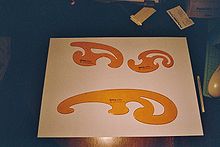Curve ruler
A curve ruler is a ruler for drawing curved lines precisely. Curve rulers are used to approximate the course of a function determined point by point by means of a continuous curve.


Types of curve rulers
Burmester templates , named after the German mathematician Ludwig Burmester , represent splines of the third order. With them, all continuous functions can be approximated. Sets with three stencils made of plastic are common, with which the most common drawing tasks in mathematics and technical lessons can be solved well, e.g. B. the drawing of polynomial curves, trigonometric functions, chain lines and ellipses. There are also more extensive sets of stencils that offer more choice and are also suitable for larger drawing formats.
In addition, curve ruler sets from EMDE and extensive special sets for drawings in shipbuilding are known and in use.
Special rulers are provided for certain curves, e.g. B. for drawing parabolas, hyperbolas or trigonometric functions. They can only be used to a very limited extent because the functions shown are based on a coordinate system on a very specific scale. An example of this are the parabolic templates , which are mainly used in math classes.
There are also flexible curve rulers made of rubber or plastic that can be adapted to almost any curve shape. The inside of the more flexible rubber rulers consists of a rectangular lead core, which is laterally surrounded by two flat strips of spring steel. This enables the ruler to be flexible in the plane, the lead core maintains its shape due to its slight rigidity and the spring steel strips protect the core and convey irregularities in the bend. In the case of plastic rulers, several flat profiles interlock, which are fixed at one end to prevent them from slipping out. A certain amount of force is therefore required to bend it into the desired curve, but this remains even after it is lifted off the sheet. In this way, the course of the line can be reproduced well on several sheets, or curves can be taken from a three-dimensional object. Flexible curve rulers are available in various lengths between typically 30 cm to 100 cm.
A special case of variable curve rulers are street slats , which consist of flexible wooden or plastic strips that are shaped and held with the help of weights, clamps and screws.
Applications
Curve rulers are mainly used today in training. Software for technical drawing ( CAD software) as well as programs that can graphically display the result of a regression analysis have largely displaced curve rulers from professional practice. However, they are still used there for small drawings or manual corrections to extensive drawings created with a pen plotter and ink pens or in the tailoring shop when making cuts.
